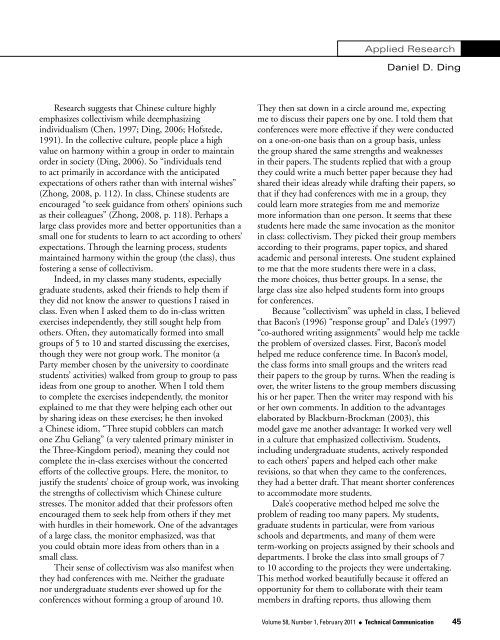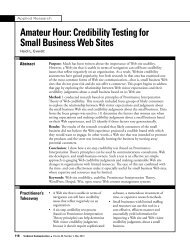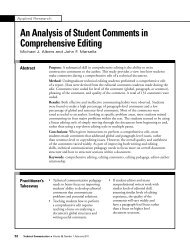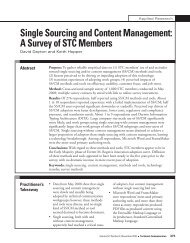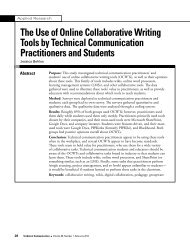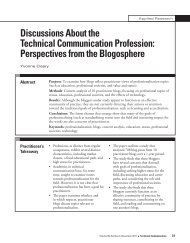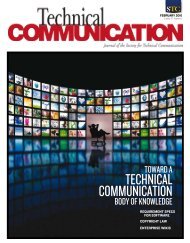When Traditional Chinese Culture Meets a Technical ...
When Traditional Chinese Culture Meets a Technical ...
When Traditional Chinese Culture Meets a Technical ...
You also want an ePaper? Increase the reach of your titles
YUMPU automatically turns print PDFs into web optimized ePapers that Google loves.
Applied ResearchDaniel D. DingResearch suggests that <strong>Chinese</strong> culture highlyemphasizes collectivism while deemphasizingindividualism (Chen, 1997; Ding, 2006; Hofstede,1991). In the collective culture, people place a highvalue on harmony within a group in order to maintainorder in society (Ding, 2006). So “individuals tendto act primarily in accordance with the anticipatedexpectations of others rather than with internal wishes”(Zhong, 2008, p. 112). In class, <strong>Chinese</strong> students areencouraged “to seek guidance from others’ opinions suchas their colleagues” (Zhong, 2008, p. 118). Perhaps alarge class provides more and better opportunities than asmall one for students to learn to act according to others’expectations. Through the learning process, studentsmaintained harmony within the group (the class), thusfostering a sense of collectivism.Indeed, in my classes many students, especiallygraduate students, asked their friends to help them ifthey did not know the answer to questions I raised inclass. Even when I asked them to do in-class writtenexercises independently, they still sought help fromothers. Often, they automatically formed into smallgroups of 5 to 10 and started discussing the exercises,though they were not group work. The monitor (aParty member chosen by the university to coordinatestudents’ activities) walked from group to group to passideas from one group to another. <strong>When</strong> I told themto complete the exercises independently, the monitorexplained to me that they were helping each other outby sharing ideas on these exercises; he then invokeda <strong>Chinese</strong> idiom, “Three stupid cobblers can matchone Zhu Geliang” (a very talented primary minister inthe Three-Kingdom period), meaning they could notcomplete the in-class exercises without the concertedefforts of the collective groups. Here, the monitor, tojustify the students’ choice of group work, was invokingthe strengths of collectivism which <strong>Chinese</strong> culturestresses. The monitor added that their professors oftenencouraged them to seek help from others if they metwith hurdles in their homework. One of the advantagesof a large class, the monitor emphasized, was thatyou could obtain more ideas from others than in asmall class.Their sense of collectivism was also manifest whenthey had conferences with me. Neither the graduatenor undergraduate students ever showed up for theconferences without forming a group of around 10.They then sat down in a circle around me, expectingme to discuss their papers one by one. I told them thatconferences were more effective if they were conductedon a one-on-one basis than on a group basis, unlessthe group shared the same strengths and weaknessesin their papers. The students replied that with a groupthey could write a much better paper because they hadshared their ideas already while drafting their papers, sothat if they had conferences with me in a group, theycould learn more strategies from me and memorizemore information than one person. It seems that thesestudents here made the same invocation as the monitorin class: collectivism. They picked their group membersaccording to their programs, paper topics, and sharedacademic and personal interests. One student explainedto me that the more students there were in a class,the more choices, thus better groups. In a sense, thelarge class size also helped students form into groupsfor conferences.Because “collectivism” was upheld in class, I believedthat Bacon’s (1996) “response group” and Dale’s (1997)“co-authored writing assignments” would help me tacklethe problem of oversized classes. First, Bacon’s modelhelped me reduce conference time. In Bacon’s model,the class forms into small groups and the writers readtheir papers to the group by turns. <strong>When</strong> the reading isover, the writer listens to the group members discussinghis or her paper. Then the writer may respond with hisor her own comments. In addition to the advantageselaborated by Blackburn-Brockman (2003), thismodel gave me another advantage: It worked very wellin a culture that emphasized collectivism. Students,including undergraduate students, actively respondedto each others’ papers and helped each other makerevisions, so that when they came to the conferences,they had a better draft. That meant shorter conferencesto accommodate more students.Dale’s cooperative method helped me solve theproblem of reading too many papers. My students,graduate students in particular, were from variousschools and departments, and many of them wereterm-working on projects assigned by their schools anddepartments. I broke the class into small groups of 7to 10 according to the projects they were undertaking.This method worked beautifully because it offered anopportunity for them to collaborate with their teammembers in drafting reports, thus allowing themVolume 58, Number 1, February 2011 l <strong>Technical</strong> Communication 45


